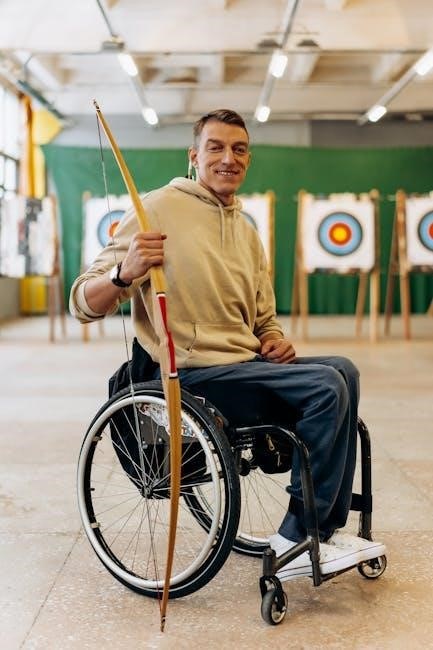Youth Strength Training Program PDF: A Comprehensive Guide
Are you looking for a structured approach to youth strength training? This guide, often in PDF format, delivers precisely that. It provides age-appropriate guidelines, exercise examples, and safety protocols. Learn how to properly design a program for young athletes.
Youth strength training is a specialized area focused on developing strength and power in children and adolescents. It’s not about bulking up like adult bodybuilding; instead, it emphasizes proper technique and safe progression. A well-designed youth strength training program can improve athletic performance, reduce the risk of injuries, and enhance overall health and well-being. Key considerations include age-appropriateness, qualified supervision, and a focus on fundamental movement patterns.
The core principle revolves around teaching kids the correct way to perform exercises. Think of it as building a solid foundation for future athletic endeavors. This involves mastering bodyweight exercises, learning proper lifting techniques, and understanding the importance of nutrition and recovery. The goal is to create a positive and engaging experience that instills healthy habits.
Often presented in PDF guides, these programs provide structured workouts, safety guidelines, and progression strategies. They offer a valuable resource for parents, coaches, and young athletes to navigate the world of youth strength training effectively. Remember, consulting with a healthcare professional or certified trainer is always recommended before starting any new exercise program.
Benefits of Strength Training for Youth
Strength training offers a multitude of benefits for young individuals, extending far beyond simply increasing muscle mass. It plays a crucial role in enhancing bone density, reducing the risk of fractures later in life. Improved muscular strength translates to better athletic performance, increased speed, power, and agility on the field or court. Furthermore, strength training contributes significantly to injury prevention by strengthening muscles and connective tissues.
Beyond the physical advantages, youth strength training positively impacts mental and emotional well-being. It boosts self-esteem, confidence, and body image. Learning new skills and achieving fitness goals fosters a sense of accomplishment and resilience. Structured exercise routines also improve focus, concentration, and academic performance. These benefits create a positive cycle, encouraging continued participation and adherence to a healthy lifestyle.
PDF guides often highlight these multifaceted benefits, providing evidence-based information to encourage parents and coaches to embrace youth strength training. It’s essential to remember that these benefits are realized when programs are appropriately designed, supervised, and tailored to the individual’s needs and abilities. A focus on fun, engagement, and proper technique ensures a positive and sustainable experience.
Safety Guidelines and Supervision
Prioritizing safety is paramount when implementing any youth strength training program. Adequate supervision by a qualified professional, such as a certified strength and conditioning specialist or athletic trainer, is non-negotiable. The supervisor should possess a thorough understanding of proper exercise technique, age-appropriate training principles, and injury prevention strategies. They must also be attentive to each participant’s individual needs and limitations.
Proper warm-up and cool-down routines are essential components of every training session. These routines prepare the body for exercise and facilitate recovery, reducing the risk of muscle strains and other injuries. Teaching and reinforcing correct exercise form is critical. Emphasis should be placed on quality over quantity, ensuring that participants master the fundamental movement patterns before progressing to more challenging exercises or heavier loads.
Furthermore, the training environment must be safe and well-maintained. Equipment should be in good working order and appropriately sized for young athletes. Clear communication between the supervisor, participants, and parents is vital. Any concerns or discomfort should be promptly addressed. A well-structured PDF guide will detail these safety protocols, empowering coaches and parents to create a secure and effective training environment.

Appropriate Age to Start Strength Training
Determining the appropriate age to introduce strength training to youth is a frequently asked question. While there isn’t a specific age cutoff, experts generally agree that children should possess sufficient emotional maturity, attention span, and the ability to follow instructions before beginning a structured program. Typically, this aligns with the age of seven or eight, but individual readiness can vary.
It’s crucial to emphasize that youth strength training is not about lifting maximal weights. Instead, it should focus on teaching proper movement patterns, developing body awareness, and building a foundation of strength and coordination. Bodyweight exercises, such as squats, push-ups, and lunges, are excellent starting points. Resistance can be gradually introduced using light dumbbells, resistance bands, or medicine balls.
The decision to start a strength training program should be made in consultation with parents, coaches, and healthcare professionals. A comprehensive PDF guide will offer age-specific recommendations and guidelines, helping to ensure that the program is safe, effective, and enjoyable for young participants. Remember that the primary goal is to promote long-term health and fitness, not to achieve rapid strength gains. Focus on proper form and technique, and progression should be gradual and individualized.
Key Components of a Youth Strength Training Program
A well-designed youth strength training program encompasses several essential components. First and foremost, a thorough warm-up is critical to prepare the body for exercise. This should include dynamic stretching and light cardiovascular activity, enhancing blood flow to the muscles and improving joint mobility. Following the warm-up, focus on fundamental movement patterns.
These patterns include squatting, hinging, pushing, pulling, and carrying. Exercises should be selected to address all major muscle groups, promoting balanced development. Proper technique is paramount, so instruction from a qualified coach or trainer is essential. Start with light resistance and gradually increase the load as the child’s strength and coordination improve.
Cool-down and stretching exercises are crucial for promoting flexibility and reducing muscle soreness. The program must also incorporate progressive overload, gradually increasing the intensity or volume of training over time. Adequate rest and recovery are equally important, allowing the body to adapt and rebuild. Finally, the program should be fun and engaging, fostering a positive attitude toward physical activity and promoting long-term adherence. A comprehensive PDF guide will outline these components in detail, providing practical strategies for implementation and modification.

Exercise Selection and Technique
Choosing appropriate exercises and mastering proper technique are foundational for safe and effective youth strength training. Exercise selection should prioritize multi-joint movements, such as squats, lunges, push-ups, rows, and overhead presses. These exercises engage multiple muscle groups simultaneously, promoting overall strength and functional fitness. Bodyweight exercises are an excellent starting point, allowing children to develop fundamental strength and coordination before progressing to external loads.
When introducing resistance, start with light weights or resistance bands, focusing on perfect form. Emphasize controlled movements through a full range of motion, maintaining proper posture and alignment. Qualified instruction is crucial to ensure correct technique, preventing injuries and maximizing results. Coaches and trainers should provide clear and concise cues, correcting errors and reinforcing proper form.
Progression should be gradual, increasing the weight or resistance only when the child can consistently perform the exercise with good technique. Avoid exercises that place excessive stress on joints or require advanced coordination. Remember, the goal is to build a solid foundation of strength and movement skills, not to lift maximal weights. A comprehensive PDF guide will provide detailed exercise descriptions, technique tips, and progression strategies, helping you create a safe and effective training program.
Sample 4-Week Strength Training Program for Pre-Teen Athletes
This sample program provides a foundation, emphasizing fundamental movements and proper technique, ideally found within a comprehensive PDF guide. It assumes three sessions per week, focusing on full-body workouts. Remember, this is a template; adjust based on individual needs and abilities. Week 1 focuses on bodyweight exercises, establishing a base level of strength and coordination. Exercises include squats, push-ups (modified if needed), lunges, rows (using resistance bands), and planks. Each exercise is performed for 2 sets of 10-12 repetitions, with adequate rest between sets.
Week 2 introduces light external resistance, such as dumbbells or medicine balls. Continue with the same exercises, gradually increasing the weight only if proper form is maintained. Weeks 3 and 4 progressively increase the resistance or repetitions, challenging the muscles further. Introduce variations of exercises to maintain engagement and prevent plateaus.
For example, try incline push-ups or different lunge variations; Remember to prioritize technique over weight, ensuring each movement is performed correctly and safely. Always supervise pre-teen athletes during strength training sessions, providing guidance and correcting any errors. A warm-up and cool-down are essential components of each workout, preparing the body for exercise and promoting recovery. This structured approach, properly outlined in a PDF, sets pre-teen athletes on the right path.
Frequency and Volume Recommendations
Determining the appropriate frequency and volume is crucial for a safe and effective youth strength training program, often detailed within a PDF guide. For pre-teen athletes, 2-3 non-consecutive days per week are generally recommended to allow for sufficient recovery. This frequency allows for adaptation without over stressing young, developing bodies. Volume, referring to the number of sets and repetitions, should be carefully managed.

Typically, 1-3 sets per exercise are sufficient, with a repetition range of 6-15. The specific number depends on the exercise and the individual’s fitness level. Start with the lower end of the range and gradually increase as strength improves. Proper form should always be the priority over the number of repetitions. Rest periods between sets are important for recovery, allowing muscles to replenish energy stores. 60-90 seconds of rest is usually adequate.
Progressive overload is key, but it must be implemented cautiously. Small, incremental increases in weight or repetitions are preferable to large jumps. Monitor the athlete’s response to training, looking for signs of fatigue or overtraining. Adjust frequency and volume as needed, prioritizing safety and long-term development. Remember, consistency and proper technique are more important than pushing for rapid gains. A well-structured PDF guide will provide detailed recommendations tailored for youth athletes.
Progression and Periodization
Progression and periodization are vital components of a well-designed youth strength training program, often outlined in a comprehensive PDF guide. Progression refers to gradually increasing the demands on the body over time, ensuring continuous adaptation and improvement. This can involve increasing weight, repetitions, sets, or the complexity of exercises. However, progression should be slow and controlled, prioritizing proper form and technique.
Periodization involves planning training in phases or cycles to optimize performance and minimize the risk of overtraining. For youth athletes, a simple linear periodization model is often appropriate. This involves gradually increasing the intensity (weight) while decreasing the volume (repetitions) over time. For example, starting with higher repetitions and lower weight in the initial phase and gradually transitioning to lower repetitions and higher weight in subsequent phases.
It’s crucial to incorporate deload weeks or periods of reduced training volume to allow for recovery and prevent burnout. These deload periods can involve reducing the weight, repetitions, or frequency of training. Monitoring the athlete’s response to training is essential to adjust the progression and periodization plan as needed. Factors like age, training experience, and individual goals should all be considered. A good PDF resource will provide sample periodization plans tailored to youth athletes.
Importance of Nutrition and Recovery
Nutrition and recovery are paramount for youth athletes participating in strength training programs, often highlighted in PDF guides. Proper nutrition provides the fuel and building blocks necessary for muscle growth, repair, and overall development. A balanced diet rich in protein, carbohydrates, and healthy fats is essential to support the demands of training. Protein is crucial for muscle protein synthesis, while carbohydrates provide energy for workouts.
Adequate hydration is also vital, as dehydration can impair performance and increase the risk of injury. Encourage young athletes to drink plenty of water throughout the day, especially before, during, and after training sessions. Recovery involves allowing the body sufficient time to repair and rebuild after exercise. This includes getting enough sleep, managing stress, and incorporating active recovery techniques.
Sufficient sleep is crucial for hormone regulation and muscle recovery. Aim for 8-10 hours of sleep per night. Active recovery, such as light stretching or foam rolling, can help reduce muscle soreness and improve blood flow. Proper nutrition and recovery strategies are integral to maximizing the benefits of youth strength training and minimizing the risk of injury or overtraining. Always consult a registered dietitian or sports medicine professional for personalized recommendations.
In conclusion, a well-designed and properly implemented youth strength training program, often detailed in PDF guides, offers substantial long-term benefits that extend far beyond the immediate gains in strength and power. These benefits encompass improved bone density, enhanced motor skills, increased self-esteem, and a reduced risk of injuries. Instilling healthy habits early on fosters a lifelong commitment to physical fitness.
Sustainability is key to realizing these long-term advantages. A sustainable program emphasizes proper technique, gradual progression, and enjoyable activities to maintain engagement and prevent burnout. It also integrates seamlessly into the athlete’s overall lifestyle, considering factors such as school, family, and other commitments. Educating young athletes about the importance of nutrition, recovery, and injury prevention empowers them to take ownership of their health and fitness journey.

Furthermore, creating a supportive environment with qualified coaches and encouraging peers fosters a positive and sustainable training experience. By prioritizing safety, education, and enjoyment, youth strength training programs can lay the foundation for a lifetime of health, wellness, and athletic success. Remember to consult with healthcare professionals for personalized guidance. A sustainable approach ensures continued progress and lasting positive impacts.
